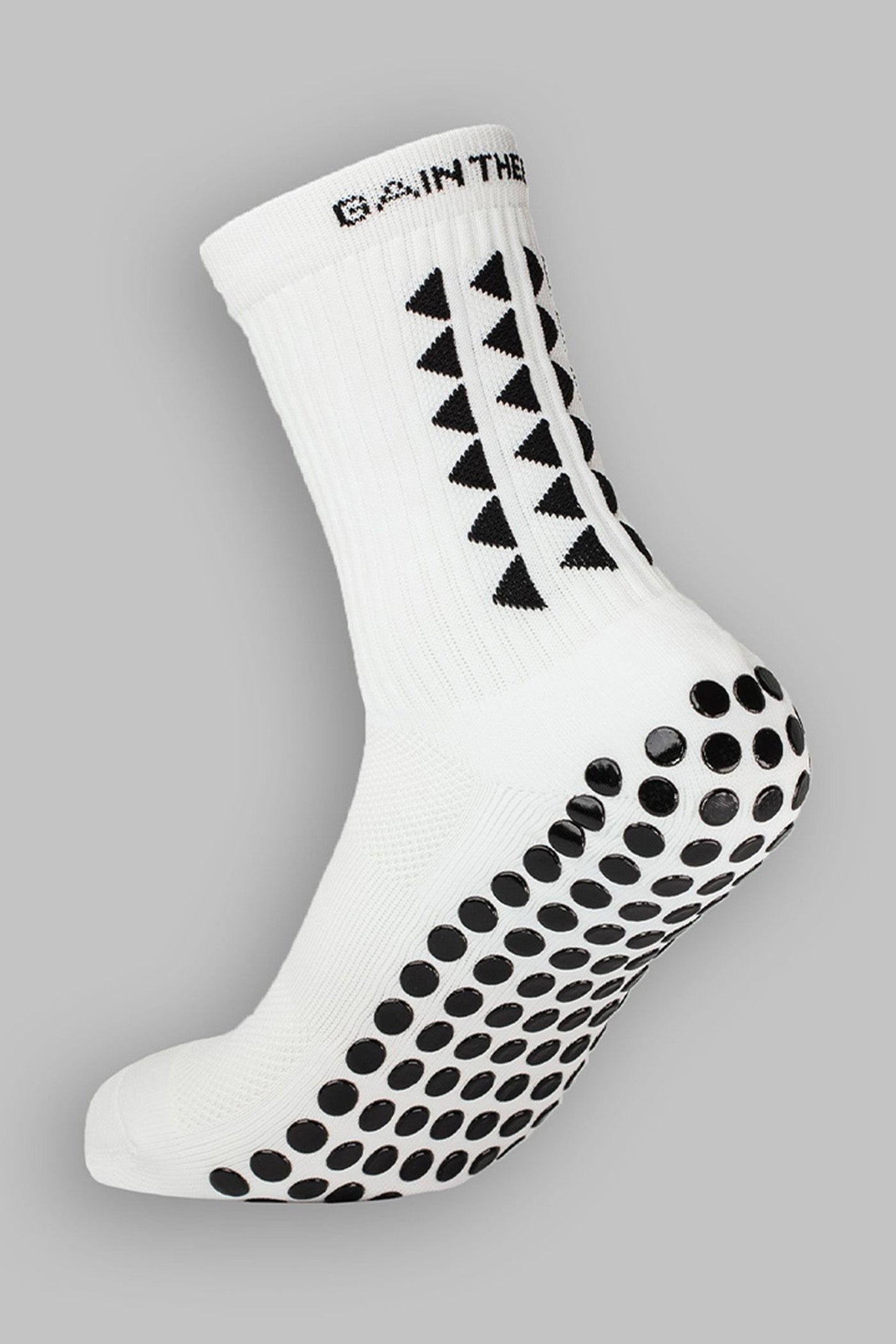Do you want to know how to wear compression socks properly? Look no further! Because of their health and performance benefits, compression socks have become a popular choice for any fitness enthusiast. They help improve blood flow, reduce muscle fatigue, and give must-have support for almost any sport or exercise.
But to get the most out of them, you need to know how to use them correctly.
Luckily, we have the guide for you. With the help of our experts, you’ll know how to wear compression socks like a pro in no time.
So whether you’ve been working out for a long time or are new to the world of exercise and compression socks, these tips and tricks are for you.
What this article covers:
- Choosing the Right Compression Socks
- Preparing to Wear Compression Socks
- How to Wear Compression Socks: Step-by-Step Guide
- Maintaining & Caring for Your Compression Socks
Choosing the Right Compression Socks
Different Types of Compression Socks
Different kinds of compression socks will give you different benefits depending on your needs. Some examples include:
- Knee-high: These socks reach just below the knee and are great for running, cycling, or walking. They hold the feet and calf muscles together and support them.
- Thigh-high: These socks go up to the middle of your thigh and give your thigh muscles more support. They are good for things like hiking and weightlifting that use the whole leg.
- Open-toe: Open-toe compression socks offer the same support and compression as closed-toe socks. The difference is that they let your toes breathe and move more, which makes them great for yoga or Pilates.
- Stirrup: The heel of stirrup compression socks is open, so the ankle can move more, and more air can get in. They are great for dance and gymnastics, which require more freedom of movement.
How to Pick the Right Size & Compression Level
To remain comfortable and get the most out of your socks, it's crucial to choose the right size and level of compression. Here are some things to take into account:
- Measure your legs: To measure for compression socks, take the circumference of your calf and the distance from the bottom of your heel to where your knee bends.
- Decide on the level of compression: There are different levels of compression socks, which are usually measured in millimeters of mercury (mmHg). Mild (8–15 mmHg), moderate (15–20 mmHg), and firm are common ranges (20-30 mmHg).
- Think about what you're doing: The best compression socks depend on the type of exercise you'll be doing. For example, runners might choose knee-high socks with moderate compression, while weightlifters might prefer thigh-high socks with firm compression.
Preparing to Wear Compression Socks
Before wearing compression socks, make sure your legs are clean and dry. To prepare your legs for putting on your compression socks, follow these steps:
- Take a shower or wash your legs with soap and water to get rid of sweat and dirt.
- Dry your legs, paying special attention to your feet, ankles, and the backs of your knees.
- If you need to, you can put moisturizer on your legs and feet. Make sure the moisturizer is fully absorbed before putting on your compression socks. If your legs are too slippery, your socks can fall off or bunch up.
How to Wear Compression Socks: Step-by-Step Guide
Putting on the Socks
Turn the Socks Inside-Out
To start putting on your compression sock or compression stocking, grab the top of the sock and turn it inside out until you get to the heel. This makes it easier to put the sock on your foot and leg because you can see what's inside.
Position Your Foot in the Sock
Put your foot into the sock with the heel section facing the right way and the toes facing the wrong way. Make sure your toes and heel fit comfortably in their designated areas.
Gradually Roll the Sock up Your Leg
Roll the sock gently over your ankle and calf as you slowly pull it up your leg. Make sure to spread the fabric out evenly as you go so that it doesn't bunch up or get wrinkled. Depending on the type of sock, keep going until it's where you want it, either just below the knee or up to the thigh.
Ensuring the Correct Fit
Adjust the Socks for Comfort
After you put the sock on your foot, ankle, and leg, make any changes you need to make sure they fit well. To make sure your compression socks are the correct tightness, check that they are firm, but not so tight that it hurts.
Make sure that the top of the sock doesn't dig into your skin. If it does, it might be uncomfortable or hinder blood flow. If you run into this problem, we recommend sizing up your compression socks.
Make Sure the Socks Don't Bunch or Wrinkle
Check your compression socks for wrinkles or bunching. These can cause uneven pressure and make the compression less effective. Make sure there are no bumps and that the sock fits your leg tightly everywhere.
Tips for Easier Application
Use Rubber Gloves or a Sock Aid
If you're having trouble putting on your compression socks, a hack you can try is using rubber gloves to get a better grip on the fabric. A sock aid could also come in handy as they are specifically made to help you put on socks.
Try Different Methods for Putting on the Socks
Different methods might work better for different people. For example, you might find it easier to put your socks on while sitting down. Or you might find it easier to stand with one leg slightly bent.
Maintaining & Caring for Your Compression Socks
Washing & Drying Instructions
If you want your mid calf length grip socks to last you a long time and remain effective, it's vital to maintain them properly. Even the best compression socks need maintenance, especially if you're wearing compression stockings or socks every day. To keep them in good shape, follow these care guidelines:
- You should wash your socks after every time you wear them to get rid of sweat, dirt, and germs.
- Use mild soap and normal temperatures when you wash.
- Turn the socks inside out for the best results.
- You can dry your socks by laying them flat or hanging them up. Don't put the fabric in direct sunlight because it could fade or lose its shape. Don't use a dryer as the heat can damage the fibers.
Prolonging the Life of Your Socks
To prolong the life of your socks, we recommend the following:
- Swap out your socks: If you wear compression stockings or socks every day, you might want to have more than one pair so you can switch between them and give each pair a chance to rest and heal in between uses.
- Take care when you put them on: Don't pull too hard or stretch them too much. This can damage the fibers and make them less flexible.
- Cut your nails short and take your jewelry off: Keep your nails short so that they don't get caught in the fabric. Take off any jewelry that could get caught on your socks before putting them on or taking them off.
Signs that It's Time to Replace Your Compression Socks
If you want to keep getting the most out of your compression socks, it's important to keep an eye out for these signs:
- Loss of elasticity: If your socks aren't as firm or supportive as they used to be, it's probably time to get a new pair.
- Fraying or holes: Socks that show signs of wear, like fraying or holes, have reached the end of their useful life.
- Less compression: While the compression level you need might vary, if the socks don't have the right amount of compression anymore or feel looser than usual, that's a sign they're no longer working.
It's important to replace your socks or compression stockings regularly if they're showing signs of wear and tear if you want to continue to reap their benefits. This is especially true if you're using them to treat medical issues such as leg swelling, deep vein thrombosis, blood clots, or varicose veins.
Conclusion
If you want to get the most out of compression socks and improve your athletic performance, it’s vital to wear them correctly. By following our tips and tricks, you'll have them on and boosting your performance in no time.
With our knowledge and wide range of choices, you can confidently step into the world of compression socks. Start wearing them today to give your performance the boost it needs.
Did our blog meet your needs? You might also find our other guides helpful:
- What Do Compression Socks Do?
- Can You Wear Compression Socks to Bed?
- How Long Does It Take for Compression Socks to Work?
- Wearing Compression Socks Too long
- Can You Wear Compression Socks All Day?
- Compression Socks vs Sleeves
- Easy to Put on Compression Socks for Elderly
- How Long to Wear Compression Socks for
- What Are Crew Socks?
- Socks as Gifts
- Best Sock Material
- What Do Grip Socks Do?
- Do Running Socks Make a Difference?
- Compression Socks for Runners
- How to Wear Grip Socks

















